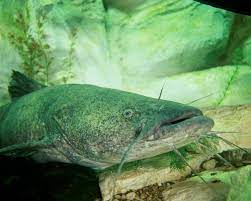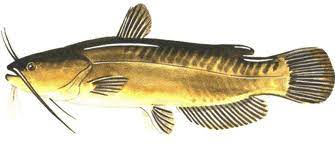Catfish have gained a great deal of popularity among anglers in the last decade or more. This is due to a few factors:
- Wide distribution in the contiguous U.S.
- Simplicity of techniques and gear required.
- Easy targets as they are ravenous feeders.
- Powerful fighters that can be caught easily without a boat from most banks.
- They are the largest freshwater gamefish in the U.S. (outside of the sturgeon)
- Excellent table fare with delicate, mild-tasting flesh.
All North American Catfish have four pairs of barbels (whiskers); a fleshy adipose fin on their backs; smooth, scale-free skin, and bony spines in front of the dorsal and pectoral fins.
There are 37 species of them, most notably channel, blue, flatheads, white catfish and bullheads. Although these species have a lot in common, there are some significant differences that anglers need to understand in order to be successful.

CHANNEL CATS
Channel cats are the most adaptable of North America’s big catfish. They can survive in most any unpolluted warm water environment. They thrive in medium to large rivers, and in shallow to mid-depth reservoirs and lakes. They prefer slow to moderate current, 75 to 80 degree water, and a sand, gravel or rubble bottom.
 SOURCE: tpwd.texas.gov
SOURCE: tpwd.texas.gov
Of all the catfish, channel cats have the least selective food habits. They will take live fish as well as dead or rotting fish, aquatic and terrestrial insects, crayfish, crabs, snails and clams. They may feed any time of the day or night, but anglers will tell you that feeding is the heaviest just after sundown.
They are willing biters that respond to “stinkbaits” better than other cats, and can be attracted by chumming with rotten cheese or fermented grain. They can also be taken on dried blood, chicken livers, worms, minnows and even artificial baits.
Most channel cats taken by anglers range from 1 to 10 pounds, with 2 to 4-pounders being the most common. The all-tackle world record channel cat was a 58 pound giant.
 SOURCE: fieldandstream.com
SOURCE: fieldandstream.com
BLUE CATFISH
Blue cats are big-river fish, thriving in mainstream rivers and their major tributaries. They tend to be stockier than channel cats, with a smaller head compared to the body.
 SOURCE: tpwmagazine.com
SOURCE: tpwmagazine.com
They are considered “opportunistic” feeders, as they will eat whatever food is available. Large blues do not hesitate to swallow fish weighing several pounds. The preferred food is gizzard and threadfin shad, and they will also eat insects, crayfish and clams.
Blues live the longest of the catfish, with the largest ones being more than 20 years old. Their growth depends on the bodies of water and forage availability. Unfortunately, America’s blue catfish population has declined since 1900, as dam and lock construction has blocked spawning runs and taken away the current they prefer in many places. Commercial fishing has also taken its toll, as they are excellent to eat.
Blues will take a variety of live baits, cut baits and prepared baits. In addition to hook-and-line fishing, blues are commonly taken by jug fishing, trotlining and noodling. They prefer water temps from 77 to 82 degrees, so their range is limited to mostly southeastern states and Mexico.
 SOURCE: roughfish.com
SOURCE: roughfish.com
FLATHEAD CATFISH
Also known as the mud, yellow or shovelhead cat, flatheads are the biggest of the cats, and inhabit mainly large river systems, impoundments and major tributaries. They prefer sand or gravel bottoms to soft mud ones. You’ll find them seeking cover around flooded timber, stumps or tangles of woody cover.
 SOURCE: wikipedia.com
SOURCE: wikipedia.com
An extremely efficient predator, the flathead has broad, powerful jaws with upper recurved teeth that makes it virtually impossible for prey to escape once clamped. At times they will hold on the bottom with their big mouths open waiting for smaller, hapless fish to investigate.
Their diet consists mainly of live fish, crayfish and clams, and unlike channel cats, they rarely consume rotten food. Thus, anglers use fresh, lively suckers, carp or shiners rather than any stinkbaits. They feed mainly at night, when they move from their deep woody cover to shallower areas.
Their range is broader than most cats, and in the north they spend the winter in a state of near dormancy. They can also tolerate water temps of more than 90 degrees.
 SOURCE: roughfish.com
SOURCE: roughfish.com
WHITE CATFISH
White cats resemble channels, but generally have a much smaller size and distribution. They are commonly found in sluggish streams, marshes, bayous and ponds.
 SOURCE: bassonline.com
SOURCE: bassonline.com
They are gluttonous feeders that will eat fish, fish eggs, aquatic insects, crustaceans and even pond weeds. They feed heavily during the daytime, which has led to popularity among anglers and in “fee-fishing” ponds.
They have the slowest growth rate of all the cats, and it can take 9 to 11 years for them to reach two pounds in the north, and 6 to 7 years in the south. They are scrappy fighters, but their smaller size limits popularity in regions where bigger cats are found.
BULLHEADS
Bullheads come in black, brown and yellow varieties, with the black being the most common and abundant. Bullheads are often dominant in freeze-out lakes, as they can tolerate dissolved-oxygen levels lower than other freshwater gamefish.
Their diet consists of small fish, fish eggs, worms, leeches, mollusks, and insects. Given this, you can typically catch them on most any bait. The black bullheads are the largest of the species, but are not known to be tough fighters. They favor 75-85 degree water.
 BLACK BULLHEAD SOURCE: wikipedia.com
BLACK BULLHEAD SOURCE: wikipedia.com
Brown bullheads are usually found in larger, deeper lakes, and also thrive in slow-moving streams. They differ from the blacks mainly due to their mottled sides. Their meat is reddish or pinkish, and is quite firm with good flavor.
 BROWN BULLHEAD SOURCE: fishidy.com
BROWN BULLHEAD SOURCE: fishidy.com
Yellow bullheads prefer clear water with heavy aquatic vegetation, but they can also tolerate polluted water and low oxygen levels. They are known for scavenging most any organic matter off the bottom. They grow more rapidly than the blacks and browns, but their life span seldom exceeds 7 years.
 YELLOW BULLHEAD SOURCE: ifishillinois.org
YELLOW BULLHEAD SOURCE: ifishillinois.org
So whether you’re chasing catfish or bullheads, you can be sure to find them an enjoyable species to catch and eat. -WR

